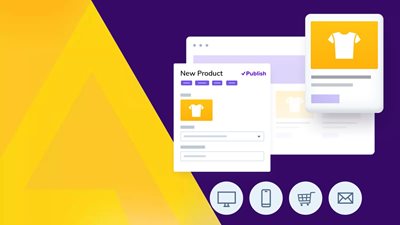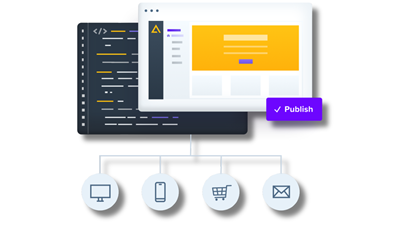What is a content-first design?


Content-first design is an approach to web design that places content at the forefront of the design process. It pushes creators to build content on their websites based on more than a pre-existing design to leverage content for the future.
In lamen's terms, the content-first design focuses on web content. To contrast, in a traditional web design, the look and feel of a site take precedence over the content. When adopting the content-first method, your web content is at the forefront of the design process and is formulated around the content needs.
A content-first design allows for more user-focused websites that are easy to navigate and nurture leads through their buyers' journey and an overall better UX. The content-first method also makes content more engaging. By designing around the content, designers can use the design to highlight key pieces of information and create a more visually appealing layout. This can make the content more exciting and engaging to users, leading to higher engagement and longer visit times.
Why should content come first in design?
Designing around the content allows designers to produce better user-focused websites. This can improve user experience by enabling users to discover the information they require quickly and easily.
Enhanced engagement:
Designers can produce a more engaging website by leveraging the design to highlight important information. Longer visits and increased concentration may result from this.
Improved search engine optimization:
Search engines like Google prioritize high-quality content websites. Designers can construct search engine-optimized websites by putting the content first, which can increase the site's exposure in search results.
Future-proofing:
Content still reigns supreme despite shifting design trends. Website designers may construct more future-proof websites by putting the content first. The website's content will always be a key component; the design can be altered over time.
How to design a page with content first
A new strategy than conventional web design is needed to create a content-first design. These are some guidelines to follow when creating a content-first design:
Specify the content:
It's essential to specify the content that will be displayed on the website before you begin designing. The site's text, pictures, videos, and other media are all included in this.
Developing a content strategy It's crucial to create a content strategy once the material has been defined. The objectives of the material, the intended audience, and the tone and style of the content must all be specified.
Layout planning:
After establishing a content strategy, you may begin thinking about the layout of your website. There should be a clear information hierarchy, and the layout should be created around the content.
Utilize visual components to support the material:
Visual components can help the content and make it more interesting. Examples include photographs, videos, and infographics.
Once a website has been developed, it is crucial to test it and make design adjustments based on user input. This can aid in pointing out where the design could be strengthened to serve the content better.

For developing content-first designs, an API-first content platform is a crucial resource. An API-first content platform allows designers to build websites around the content rather than the other way around by offering a mechanism to access content and design assets through a defined set of APIs. A successful content-first strategy is built on api-first content platforms like Agility.
API-first content platforms:
A platform built to deliver content and design assets using a defined set of APIs is known as an API-first content platform. In contrast to using a conventional content management system (CMS) or design tool, designers can now access content and design elements programmatically.
One of its main advantages is an API-first content platform's ability to help editors, developers, and designers build more adaptable and flexible websites. By making it possible to access content and design materials through APIs, designers may build specialized processes and integrations suited to their requirements.
By giving designers a mechanism to access content and design materials in a way that is tailored to their needs, an API-first content platform enables content-first design.
Why is a content platform that prioritizes APIs necessary for content-first design?
Access to structured content is made possible by an API-first platform, which also makes it simple to organize and display that content on a website. Rather than attempting to squeeze material into an existing design, designers can more easily construct websites designed around the content.
Workflows that can be customized:
An API-first content platform enables designers to build workflows suited to their own requirements. Custom design processes are customized for their particular design process and individual tool and platform integrations are two examples of this.
Flexibility and adaptability:
An API-first content platform enables users to build custom solutions that cater to their particular needs rather than relying on pre-built templates and procedures, which gives users flexibility and adaptability.
Collaboration between designers and developers can be improved with an API-first content platform. The availability of a defined set of APIs for gaining access to content and design assets enables designers and developers to collaborate more closely and provide solutions that are uniquely suited to their own requirements.
Future-proofing
Another crucial component for future-proofing a website is an API-first content platform. Designers can leverage the content platform's APIs to build specialized solutions geared toward the latest design fads and technological advancements.
Why use Agility?
For several reasons, Agility is the finest content platform for using a content-first strategy. When it comes to content-first design, Agility differs from other content platforms for the following principal reasons:
API-first Architecture:
A set of standardized APIs is used to access content and design assets because Agility is designed on an API-first architecture. Instead of using a conventional content management system (CMS) or design tool, designers can access content and design assets programmatically.
A content-first strategy requires a high level of flexibility and adaptability, which this technique offers. Agility enables designers to create specialized solutions that are catered to their unique requirements by giving them access to organized content and adaptable procedures.
Content Modelling
Another important factor making Agility the finest content platform for a content-first strategy is its capacity for content modelling. The process of establishing the structure of content, which can encompass anything from page templates to content kinds, is known as content modelling.
Designers may describe the structure of the content in a way that is suited to their unique needs, thanks to Agility's content modelling capabilities. By using this strategy, designers can more easily construct websites that are built around the content rather than attempting to squeeze the material into an already-designed layout.
Multi-channel Publishing
Finally, Agility is the greatest content platform for a content-first strategy because of its multi-channel publication capabilities. Thanks to multi-channel publishing, designers may produce content once and publish it to various channels, like websites, mobile apps, and digital signs.
This method makes it simpler for designers to provide optimized material for multiple channels without having to produce numerous versions of the same piece of information. Also, it makes it simpler to maintain consistency across several platforms, a requirement for a seamless user experience.

About the Author
Harmonie is the Senior Marketing Manager at Agility CMS
View Related Resources

What is Content Architecture & Why It's Important

An Intro to Content Modeling

